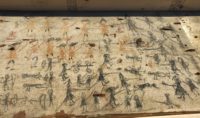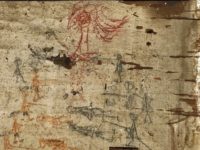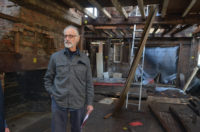 Restorers have discovered a battle scene believed to be from the French and Indian War drawn on the wall of a 17th-century home in East Hartford, Connecticut. A crew from the Glastonbury Restoration Company, a firm that specializes in restoring historic structures, was removing old plaster to reach the original wooden frame of the house when he uncovered a much older plaster wall covered with a mural five feet wide drawn in primitive style.
Restorers have discovered a battle scene believed to be from the French and Indian War drawn on the wall of a 17th-century home in East Hartford, Connecticut. A crew from the Glastonbury Restoration Company, a firm that specializes in restoring historic structures, was removing old plaster to reach the original wooden frame of the house when he uncovered a much older plaster wall covered with a mural five feet wide drawn in primitive style.
It’s a rudimentary drawing that is nonetheless incredibly active and detailed. In different colors of charcoal and chalk, it depicts a complex battle scene with soldiers in different colored uniforms, complete with winter coats and hats, cannon being moved on carts, Native Americans wielding bows and arrows and dead bodies with arrows protruding from them.  There’s even a mysterious red tree-like creature in the middle of the scene who appears to have some human facial features and is waving his thick branchy “hair” in the wind. Where was the Whomping Willow in the 1700s? (I demand a cut of any prequel JK Rowling writes based on this idea.)
There’s even a mysterious red tree-like creature in the middle of the scene who appears to have some human facial features and is waving his thick branchy “hair” in the wind. Where was the Whomping Willow in the 1700s? (I demand a cut of any prequel JK Rowling writes based on this idea.)
Glastonbury Restoration Company owner Steve Bielitz has found plenty of graffiti in the many houses he’s worked on over the years, but nothing even remotely like this. He showed the work to art experts in Connecticut and other states, among them University of Delaware architectural historian Michael Emmons Jr. who described it as an extremely rare 18th century “architectural sketch”
Emmons said he has documented thousands of graffiti and wall markings across the country. He said a vast majority were created by young males — ages 10 to 30 — but mostly by teenagers. He said although the drawing looks like it may have been created by a child, that’s not the case.
“Rudimentary drawings and less literate writings often reveal younger people’s handiwork, but admittedly, these things can also be misinterpreted because it “looks” like it’s done by a young person, when in reality it was done by someone who just couldn’t write or draw well,” he said.
Emmons said he believes the drawing could have been made by a family member after being told the story of the battle. […]
“My gut sense here is that these images were created by a younger person, rather than even a young soldier who has fought in a war. This does not preclude the possibility of these images being drawn by someone who actually participated in a war, which is definitely possible, but my instinct is that this is a younger person drawing a scene they’ve read about or heard about, or maybe even recreating an event that a family member experienced,” he said.
There certainly would have been a myriad opportunities for that kind of transmission. The home is the oldest surviving house in East Hartford, dating to the Colonial era around 1693. Its first owner was Jonathan Hills, the youngest son of William Hills who was one of the founders of Hartford. William Hills had emigrated to what was then the Massachusetts Bay Colony in 1632, and moved to Hartford four years later. He accrued significant property in a very short time, including more than 500 acres in land in an area of Hartford called Hockanum on the east bank of the Connecticut River. Hockanum would become East Hartford in 1783.
William Hills was a captain in the Hartford militia. His son William, Jr., died in King Philip’s war in 1675, shot by an Indian arrow. The family’s military tradition continued for generations. Jonathan was a lieutenant in the colonial regiments, as was his son David Ensign Hills and his son David. The latter is known to have to fought in the French and Indian War (1754–1763).
The artwork was made on the wall in situ, perhaps by a family member to entertain and educate the children. We know a renovation after 1850 covered the wall with another plaster wall because some of the figures in the mural were found behind a stud. The date hasn’t been able to be narrowed down any further than that yet. The drawing will be studied further by Michael Emmons at the University of Delaware. It will be analyzed with infrared photography and reflectance transformation imaging which may reveal details invisible the naked eye.
 As for its final disposition, that is up in the air at the moment. The house is still owned by descendants of the Hills family. They are having it dismantled piece by piece and moved to South Carolina. They own the mural, of course, as it is literally a piece of their house. They might put it back on the wall where it was discovered.
As for its final disposition, that is up in the air at the moment. The house is still owned by descendants of the Hills family. They are having it dismantled piece by piece and moved to South Carolina. They own the mural, of course, as it is literally a piece of their house. They might put it back on the wall where it was discovered.